r***UPDATED: 8/4/22***
Home Theater projectors and screens over the past 20 years have had quite a metamorphosis.
At the turn of the century (2000, not 1900), most quality projectors were dim (less than 1000 lumen), had expensive bulbs with short life (350-600 hours and cost $250-500), and you had to have a dedicated, light controlled room to view movies for movie night (because of the bulb life) and your projector had to be between 12-20 feet from the screen with cables running up walls and through ceilings. The projectors themselves were Standard Definition (same as your 4:3 TV) and generally were thought for the rich. Screens were generally vinyl with a 1.0 gain and a thick border, like in a movie theater.
Fast forward to present.
“TV’s are the best way to have a home theater”
TV’s have gotten bigger, brighter, thinner, and after initial high price, cheap sets are selling for a couple hundred, 65” TV’s (US average purchased size in 2019 was 50”) for less than a grand, and they have features like 4K, High Dynamic Range, Dolby Vision, smart features and a lot of bells and whistles, some features are genuinely needed and some are simply silly marketing.
However, with large LED/LCD/OLED HDTV’s there are a few drawbacks.
One of which is that no matter what the screen type (with a possible exception by Samsung and Sony and a special IPS non-reflective surface) is highly reflective. This is OK in a dark room, but in a regularly lit room, especially with windows, reflection is a major nuisance, requiring specialty mounts that tilt and move, or you always watch TV with the blinds closed because of the reflections.
Also as you increase in size on a TV, the more expensive and heavier the TV becomes and some technologies (OLED) are limited in maximum size. An 86” LG thin TV is about $3000 and weighs 100 pounds and you better have that in studs on all your mount points, or you end up with it on a table with tie down straps to prevent injury if it falls
Did you know that every 30 minutes, a person is brought to an ER because of an improperly mounted TV, most are children who pulled the TV on themselves?
You are also limited to where you can mount a TV, and unless you buy one of Samsung’s “The Frame” with Art that shows when the TV is off, you have a very large black, reflective, box on your wall.
“Oh, but what about those light walls I heard about?”
Samsung and LG have come out with their “direct view” (mini/nano/micro) LED technology (similar to the full color digital road signs) that allow an installer to build a screen however big they want (they showed off a 237” diagonal TV at CES), but to do a 120” TV, the cost is in excess of $120,000, a dedicated 220v circuit and weighs somewhere around 250 lbs. This naturally will come down in price and technology will make it thinner and easier to build, but we are looking at 10 years before this technology is available for anyone other than corporations and the very rich. This year Samsung came out with a 98″ 4K TV, for $15,000 and weighs, by itself, 135 pounds.
There was an adage that told kids that if they sat too close to a TV, it would ruin their eyes. This wasn’t because of some mystical radiation or the moronic content on the TV, but from eye strain. You watch any TV, you are staring at a light bulb for all intents and purposes. So people sit farther away from their TV’s, usually about 8-10′.
A couple of years back, THX asked families what their biggest regret was in their purchase of a TV. Their answer was “We should have bought a bigger TV”. They also set what the standard for “immersion” (similar to in a movie theater) as the distance from your screen.
For a 100″ screen that distance is the aforementioned 8-10′.
For a 65″ screen, it is 4′ away for the same effect.
That is not immersion, that is pathetic.
Enter projectors and screens.
Projectors and screens eliminate the #1 and #2 complaint about HDTV’s. Projector screens are much lighter (between 10-40 pounds), their screens are non-reflective, and unless you purchase Screen Innovations Black Diamond Screen, does not look like a large, black monolith on your wall. Additionally, if you use drop down or rise-up screens, you won’t see the screen unless you are ready to watch your projector.
There are 3 keys in the selection of the right projector and screen.
1. How much control do you have over your lighting situation?
2. How much room do you have for mounting a projector? Size of Screen?
3. What is your budget?
1. Light control is very important as projectors by nature are reflective, the more light you add to a room, the more washed out your image will be with a plain white screen (more about screens below), so you would need to move up to an Ambient Light Rejecting (ALR) screen.
2. The amount of space you have available where you are going to have a projector determines the type and model of projector and the size of screen. If your room is less than 12 feet, a standard throw projector will not work for any screen 100″ or above. This leaves you with a short throw projector or an ultrashort throw (UST) projector. There is a projector calculator https://www.projectorcentral.com/projection-calculator-pro.cfm that allows you to try out different projector models with different screen sizes and see if you have the distance.
NOTE: Measurements of distance are from the lens in front. That doesn’t include the body of the projector. So if you have minimum “throw distance” of 11′ and your projector body is 24″, you must have at least 13′ or more to mount the projector.
3. Budget. As opposed to TV’s, there are three parts to budget for 2 piece projection: The projector, the screen, and audio support (with the exception of UST projectors which normally have decent built in audio).
PROJECTORS:
Once you have decided on what type of projector you want, the price can vary widely from several hundred, to tens of thousands. The most widely known projector companies are JVC, Sony, Epson, Viewsonic, LG, Samsung, Optoma, and BenQ. Each company has their budget, midrange, and premier lines. Each uses one of four projection technologies, DiLA, LCoS, LCD and DLP. Each one has their pros and cons, the first two (JVC/Sony) being the most expensive and largest/heaviest projectors, but most color accurate projectors (now all with laser technology) and have the best processors and optics (lenses) in the industry. These are true home theater projectors that have true 4K projection. These are the projectors best in fully light controlled environments. Epson uses LCD which is three LCD screens that light is passed through then combined for an image on the screen. Pros are better light control and greyscale, cons are the size of the projectors and if the three screens become misaligned, it you get rainbows on everything. This is in the mid range of projectors, $1500 – $6000. The last technology, DLP (Digital Light Processing) utilizes micromirrors, controllers, and using magic only known by Texas Instruments, is able to display a 4K image thru “pixel wiggling” (a 1080p image is shifted a half pixel 4 times in a millisecond so your eye perceives a 4K image. Like I said, magic). This technology is found in low to mid-high range ($500 – $6000). The highest end ones use a triple laser light source, eliminating the need for a color wheel (a spinning wheel with panels of red, blue, green, yellow, and clear and when the magic says, it needs blue, the wheel spins and hit the exact moment it needs blue projected on one of the million micro mirrors and the exact microsecond it is needed. Magic). Pros are smaller and lighter cases, less expensive, brighter. These are great for media and living rooms, most are gaming capable with low input lag (Gaming at 100″+ is an amazing experience). It is also the technology used in UST projectors.
Let me put a few words out there about UST projectors. I have personally been using UST projectors for the past 5 years, the first being the Optoma GT5500+. It was my first UST projector and is still in use now in my projector rentals. Since then I have been a strong advocate for UST as it fits into the arena normally left to TV’s. The first UST out was from Sony in 2014, but the first real inroads was with the GT5500+ in 2017. Now Samsung, LG, Viewsonic, BenQ and Epson have UST projectors. Sony’s stopped making theirs (admittedly $25,000 was a bit much), leaving only JVC without a UST, yet. Optoma has the longevity and the experience in both residential and commercial applications of the UST projectors, with other manufacturers taking advantage of the advances they made. Even though they do have some drawbacks, if the projector is placed in a cabinet (like shown in the middle picture below or the video), that eliminates many of the recurring issues with UST’s of someone bumping it out of alignment. All UST projectors can do 100″, most can do 120″ with some focus issues at the upper corners. The Samsung LST9T claims 130″, although personally I haven’t seen it at 130″, but a 120″ installation was stretching it some. 100-110″ seems to be the sweet spot for these projectors. What I also think is a great advantage is you can’t block the image, and all the cable in and outputs are on the back facing the wall (if not put in a cabinet like the first picture). This gives a very clean appearance, which for many a people is preferable to a bunch of cables all over the place, or a projector hanging over their head.
UST projectors overall have a built in sound system of various levels, depending on the cost of the projector. Some are pretty minor equal to a really good TV speaker or a low end soundbar, to the higher end ones with speakers by Harmon Kardon or NuForce. If the projector is going to stay in a cabinet permanently, then a separate audio system is preferable, usually in a component fashion (see below in AUDIO), but UST projectors have the unique advantage of being portable and I use them in my projector rentals, and at demonstrations and expos. Add an inexpensive outdoor screen and you have outdoor movie night (see under PROJECTOR RENTALS for some pictures) and don’t need audio reinforcement. Also many of these projectors (particularly LG and Samsung) have the same operating system interface that they have in their TV’s, so a separate streaming box is not necessary, as long as you have a good Wi-Fi signal.
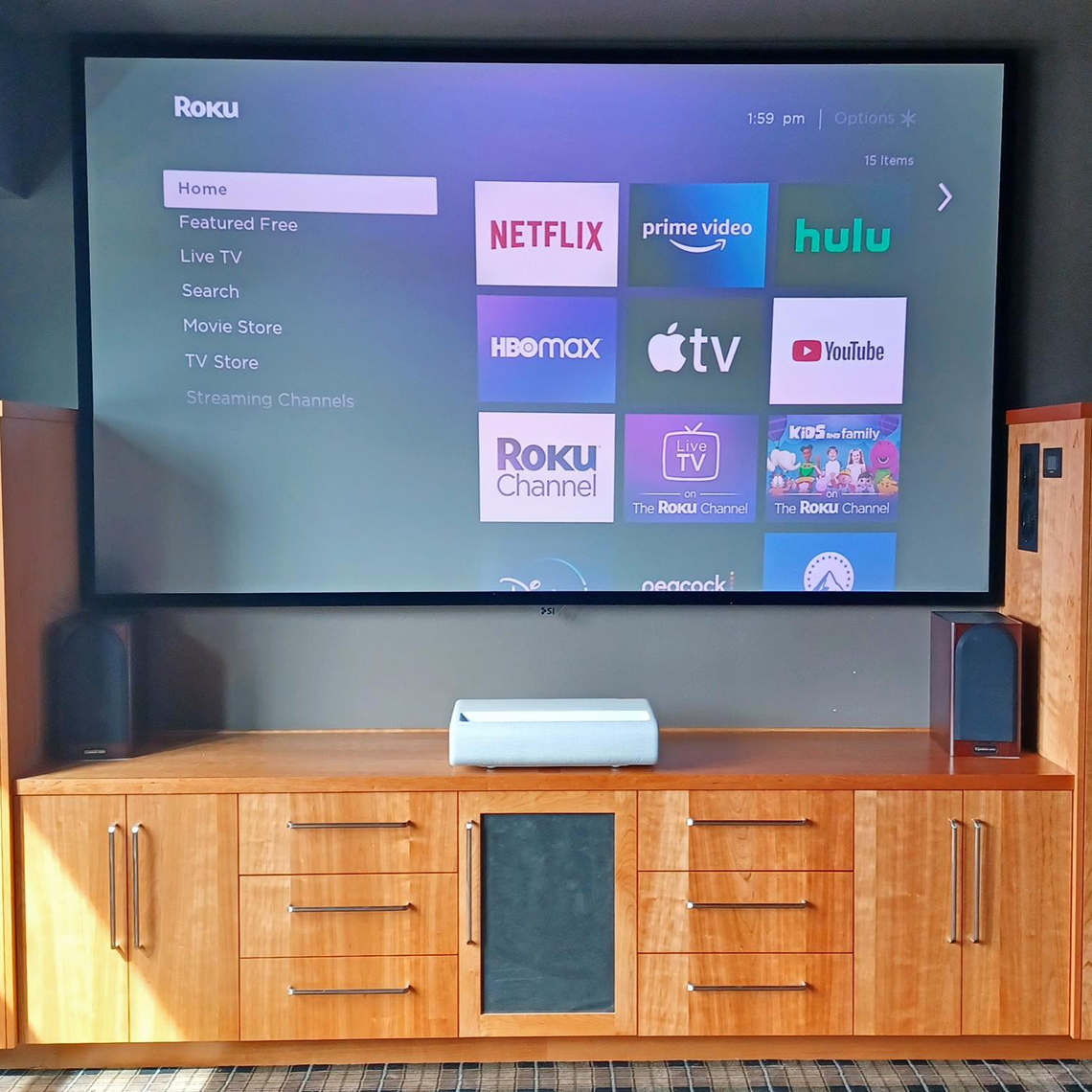
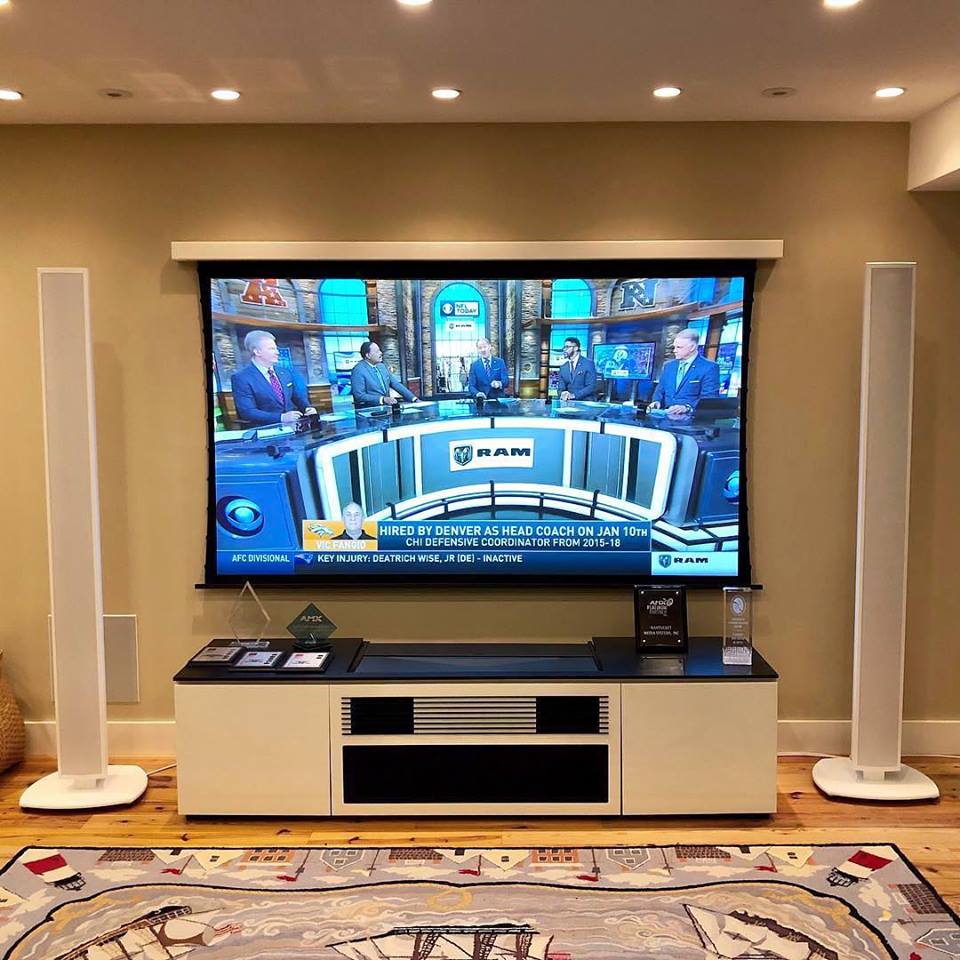
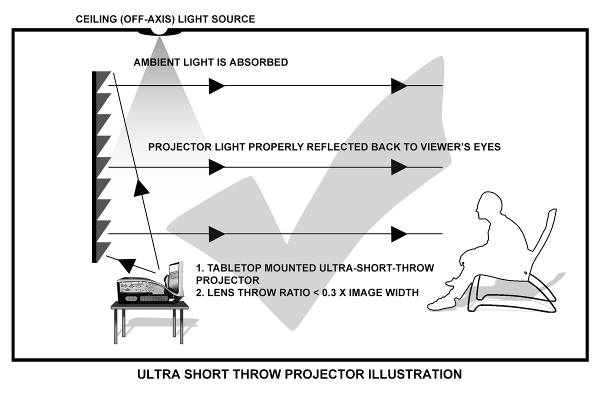
-SCREENS:
Screen costs vary greatly and depend on size, material, and hardware. Now many screen manufacturers have what is known as b-stock company fronts to sell their slow moving products. They are the same quality, just less price. Example is Elite Screens b-stock is Aeon Screens. A typical 100″ screen of 1.0 gain vinyl and a thick bezel frame is usually less than $200. ALR material on the same frame can be from $500-$800 and a UST specific screen can be over $1000. Going up in the screen realm, you get better screen materials and better hardware. These screens go into the thousands depending on all the aforementioned reasons, plus motorized (floor rising/ceiling dropping) and portable put a premium on these screens.
Screen manufacturers, Elite Screens, Stewart Filmscreens, Vividstorm, and Screen Innovations, have many types of screens from fixed with thick borders, to “Zero Edge” screens that make your screen look like a giant thin bezel TV, to portable screens that require no electrical plug ins and have screen materials from white to ambient light rejecting, to specialty materials for UST and standard projectors to get you the best image for your projector. They are split into fixed screens, motorized screens (on wall, in ceiling, or floor rising), portable, and manual pull down. There are a lot of options to fit your specific situation.
You can use a standard white, with very good
As a note: Gain is the reflective properties of the screen. If you have a screen with a 1.0 gain, that means it reflects back 100% of the light as is projected on it. A 1.2 gain screen, because of a special coating, will reflect 120% of the light. ALR (Ambient Light Rejecting) screens by their nature will dim the reflective aspect of the image, so making sure you get one with a 1.0 or higher is recommended. The aforementioned “Black Diamond” screen is a .85 screen, but is used in high ambient light conditions to improve the image.
The image above is of the screen material specifically for Ultra Short Throw projectors. It redirects the light coming from below to head straight for the viewer, while rejecting light coming from above and the sides. Speaking from experience, these screens can be used in any light situation and still look like a TV, without the annoying reflections.
Projector manufacturers and screen manufacturers together, have made it so there truly are no limits to where you can put a projector and screen, and that anyone can enjoy a movie theater experience in their home.
AUDIO
Audio reinforcement for projectors is pretty necessary since projectors themselves don’t have speakers on them (except noted). You generally need an AV receiver (Sony, Denon, Yamaha, Marantz, Pioneer, Onkyo), and speakers which can be bookshelf type, floor standing, in wall, in ceiling or wireless, although I have seen soundbar setups that have done very well (example is the Klipsch Cinema 800 placed below the screen with a wireless subwoofer and wireless surround speakers). This depends on your specific room situation, esthetics, and costs, since in-wall and in-ceiling speakers generally are less expensive than surface mount or floor mounted speakers, they entail running speaker wires through walls and ceilings which raises the overall cost. Best to have someone with experience in the AV industry for recommendations.
There you go, a brief down and dirty on the progression of projectors and projector and screen technologies. While there are some that say projection is going to go away because the quality is better with OLED TV’s, but people who do 2 piece projection, are doing it for the immersion and experience, similar to going to the movie theater. You can’t do that on a 65″ TV. And with 4K projectors, players, and disks (or streaming if you are not concerned with the higher quality image and sound) you can view movies the way, the director wanted it to be viewed, in your home.
Go big and stay home.
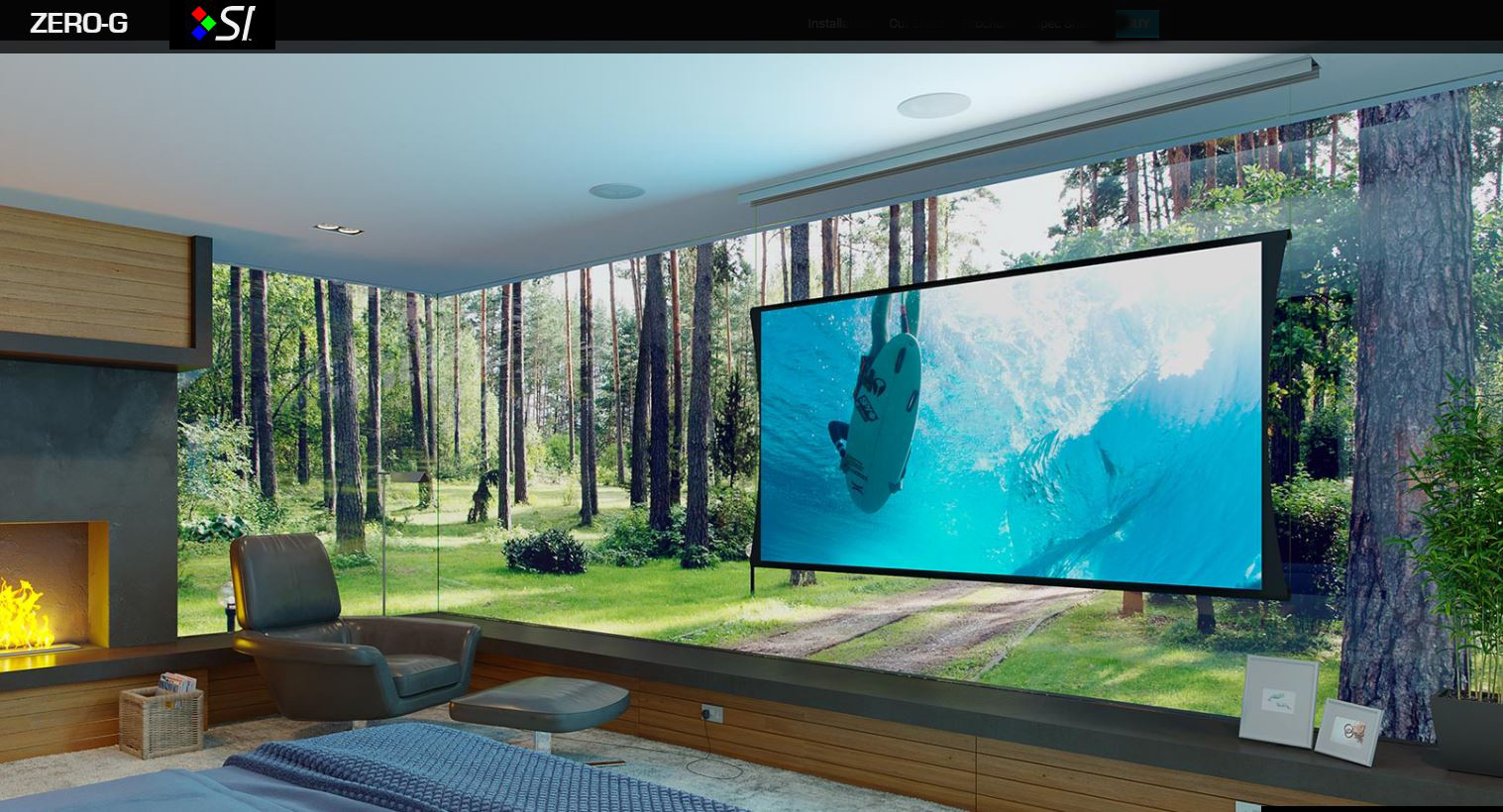


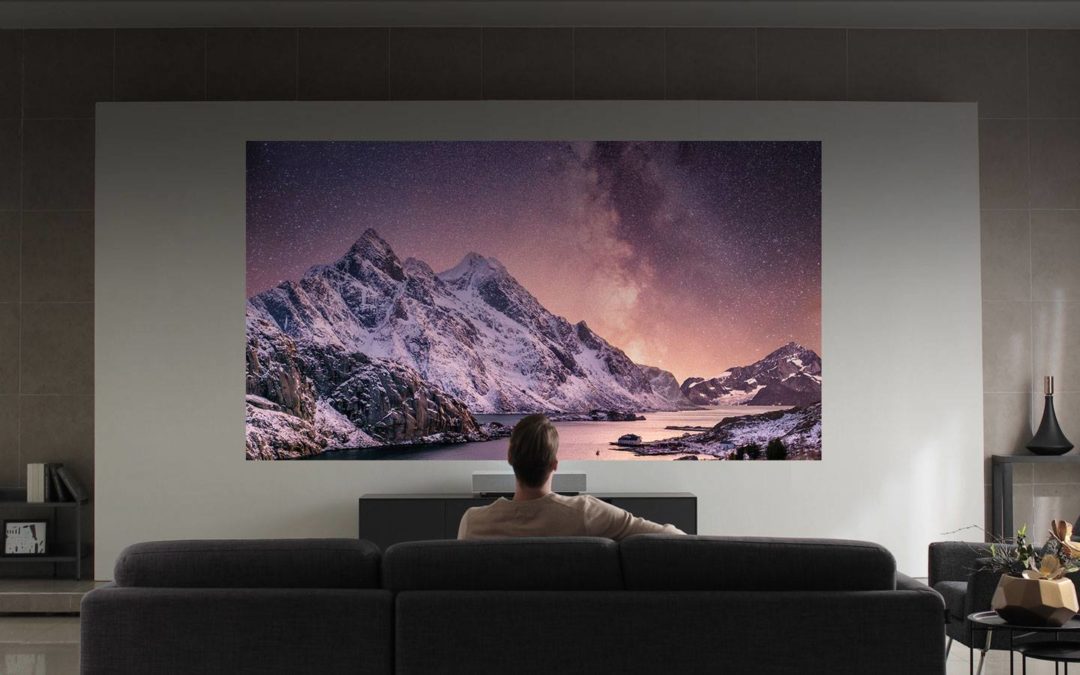
Recent Comments